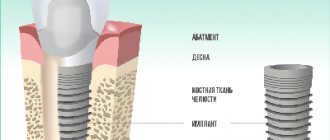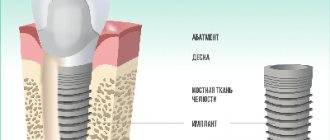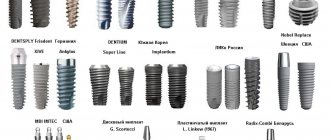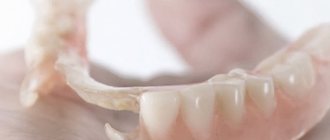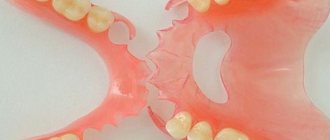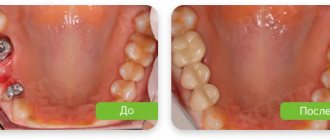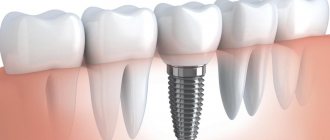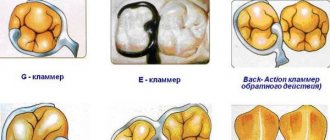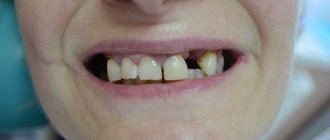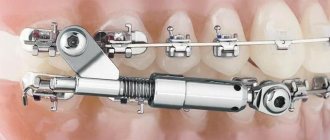Chief editor of the site:
Snitkovsky Arkady Alexandrovich
Chief physician of the professorial dentistry “22 Century”, dentist, orthopedic dentist
Author of the article:
Scientific team of dentistry “22 Century”
Dentists, candidates and doctors of medical sciences, professors
Types of Dental Implants
Today, every modern dental clinic offers such a service as dental implantation. Let's look at the basic terms and concepts, as well as types of dental implants.
Basic terms
- A dental implant is a structure that is installed into the jaw bone during surgery and replaces the roots of the teeth, and also serves as a support for prosthetics;
- An abutment is a supragingival structure that imitates a tooth stump. It can be integral with the implant (non-separable design) or as a separate structure (demountable design);
- The healing abutment is a supragingival intermediate structure. Essential for creating a beautiful natural gum margin. (in the case where the abutment and implant are a single whole, not used);
- Osseointegration is a direct structural and functional connection between living bone tissue and the surface of the implant implanted into it.
History of the first patient
The first attempts to replace lost teeth with artificial ones were made by people in antiquity and even earlier. In the form in which we know dental implants now, they appeared in the second half of the 20th century. The first successful implantation was performed in 1965 on an ordinary carpenter, Gust Larsson, who lost all his lower teeth at the age of 34, had a cleft palate, a deformed upper jaw and chin, and experienced constant pain and significant difficulty eating and speaking. Larsson volunteered for a new study led by Professor Ingvar Brånemark at the University of Gothenburg, which Güsta had heard about by chance from his dentist. After the treatment, he was able to chew, eat and speak normally. The installed implants served Gust Larsson all his life. The experience of this brave man proved that installing dental implants is the most effective way to restore lost teeth.
Implantation can be:
- Direct (performed immediately after tooth extraction);
- Delayed (3 months or more pass after tooth extraction).
Prosthetics can be performed simultaneously with the installation of an implant or also after a certain time (two-stage technique).
The choice of one or another implant or method of operation depends on the patient’s general condition , oral hygiene, the volume and quality of the jaw bone tissue, and the patient’s financial capabilities.
Free dental consultation
Our clinic offers a free examination by a dentist or implantologist. The doctor will examine the oral cavity and give recommendations for treatment and dental prosthetics.
You can read all the nuances of implantation in the article.
To find out more about prices for treatment and installation of implants, go to the appropriate section of our website. Registration for a consultation is carried out by phone and 7(920)-090-49-94, in the feedback form and during a personal visit to the clinic.
You can also find more information about installing implants in the article.
Dental implant materials
Dental implants
Depending on what material the implant is made of, there are:
Metal
Most dental implants are made of titanium and its alloys. The peculiarity of this material is such that the body does not recognize it as something foreign. In this regard, excellent biocompatibility is noted. It is also characterized by high strength and lack of toxic effects.
Ceramic
Ceramics occupies a special place in dentistry in terms of aesthetics. Its color and light transmission allow it to imitate natural teeth as closely as possible. But when it comes to implantation, aesthetics are not so important. Biocompatibility comes first. The interaction between ceramics and bone tissue has not been fully studied. Thus, we cannot say affirmatively and positively about osseointegration. Therefore, the choice of this type of material remains a big question .
According to the form they are distinguished:
Cylindrical
Thanks to the porous structure, a strong connection with the surrounding bone tissue is ensured. Currently, cylindrical implants are produced dismountable, designed for a two-stage application method.
Screw
In order to have an idea about these implants, let's look at the structure of the jaw bone.
The cortical plate is a kind of shell, the strongest, consisting of 95% mineral salts.
Spongy bone is the main layer of bone tissue, represented by crossbars and septa with many small vessels (capillaries). It is in this section that the roots of the teeth are located.
The basal layer is a continuation of the spongy layer, but the septa are located closer with a small number of vessels. Maximum strength and thickness .
Screw implants have a number of advantages:
- Cone shape;
- They are installed in place of the roots of natural teeth, that is, in the spongy layer. When chewing, they also transfer the load to the surrounding bone tissue, thereby maintaining metabolic processes in it at the proper level. It turns out that this type of implant is the most physiological;
- The presence of threads, which increases the area of contact with bone tissue, and, consequently, faster osseointegration is noted;
- They can be collapsible or non-removable, one- and two-stage, have a smooth, rough surface or a coating of bioactive materials;
- They come in different diameters and lengths, which expands the indications for their use.
One of the main conditions for the use of screw implants is the presence of a sufficient volume of high-quality bone. But even if there is a lack of it, it is possible to establish them with the help of additional operations (sinus lifting, bone grafting, etc.). Only the duration of treatment and recovery will change.
In today's market you can see many implant manufacturers. Let's take a look at the leading representatives.
Techniques
Basic surgical techniques in orthodontics include one-stage and two-stage implantation.
Two-stage
Standard implantation, which can be performed in any dental office.
Stage 1
The gum flaps are cut and moved back, clearing the bone for the implant. An axial guide channel is created with a 2-2.5 mm drill, and it is expanded with a drill of a larger diameter.
When the root portion of the implant is screw-shaped, the bone is manually threaded using taps. Then the endosseous element is screwed in using the implant lead.
If cylindrical implants are used, the bed is formed using a reamer or a special cutter. When using combined implants, first the cylindrical part is formed using fissure burs, and then preparation for the plates is carried out.
The intraosseous part of the implant is installed just below the height of the alveolar ridge. To protect against bone tissue getting inside the implant, the canal is closed with a plug, the gum flaps are raised and sutured.
Stage 2
It is carried out no earlier than 2-3 months, when it becomes clear that the root-like part of the implant is successfully engrafting. After activation of local anesthesia, the gum is excised again and the plug is removed. After flushing the canal, the upper part of the implant is screwed in. Additional incisions are sutured.
Two-stage implantation technique
One-stage
It differs from the two-stage procedure in that after implantation the entire implant protrudes into the oral cavity. It is installed by cutting the gum, or in a simplified way. This is the so-called bloodless implantation technique (no stitches are applied):
- The mucous tissue and periosteum are excised with a perforator.
- The bone bed is prepared with a drill, circular saw, or fissure bur.
- The implant is installed.
These methods of dental implantation give the same long-term results. If there are any doubts about the patient’s compliance with hygienic requirements for the cleanliness of the oral cavity, they resort to a two-stage procedure. Then the possibility decreases:
- accumulation of food plaque and bacteria on the surface of the implant;
- development of the inflammatory process;
- implant rejection.
If oral hygiene is maintained, the implant is installed in one go.
Advantages and features:
- Each implant is covered with a unique TiUnit material, thanks to which the process of osseointegration occurs much faster (in its structure and composition it is very close to bone tissue);
- 3D planning of the operation, which is the key to the accuracy and high aesthetics of the finished structure;
- Due to the design features of the thread and the body of the implants themselves, tissue trauma is minimal;
- A wide range of implants in diameter and length makes it possible to install them even in the most seemingly difficult clinical situations;
- Simplicity, logic and accuracy in the surgical protocol (operation);
- All Nobel implants have identification numbers. Fake is impossible.
The only downside worth noting is the high cost.
ASTRA TECH implants
ASTRA TECH implants
The system was developed by Swedish scientists and is popular in many countries.
Advantages and features:
- Made of the highest class titanium, which has excellent biochemical qualities;
- Modified OsseoSpeed surface, which accelerates the process of osseointegration;
- The connection of the implant to the Conical Seal Design abutment is located below the gum level, which allows for a more even distribution of the chewing load;
- Patented microthread in the upper part of the implant (in the neck area), which also improves the distribution of chewing pressure;
- The company provides a lifetime guarantee.
Among the disadvantages, high cost can be noted.
How are dentures attached?
Fastening the prosthesis after implantation depends on whether it will be removable or not.
Fixed prosthetics
In this case, the prosthesis is installed by an orthodontic surgeon once. Fastening can be using locking mechanisms or dental cement.
For cement
The prosthesis is attached to the head of the implant using dental cement. There are no holes for screws - the dentition looks solid. Fast production and low costs, coupled with speed of installation, made cement fastening widespread.
Flaws:
- Such fastening poses a risk of an inflammatory process under the prosthesis if cavities remain in the cement fixation between the gum and the prosthesis.
- If it is necessary to remove the prosthesis, parts of it may be damaged.
- If the intramaxillary space is small, a small abutment is placed, the fastening becomes less reliable, and there is a risk of losing the crown.
- Difficult to remove remaining cement.
On attachments
The prosthesis is securely attached to the implants using clasps and attachments. The shapes of the locks are different; they can be located on the outside of the crown or on the inside.
Removable dentures
Removable dentures are attached differently.
Screw fixation
The prosthesis can be attached with a screw to the implant:
- to the intraosseous part;
- to the head.
If a custom abutment is made, it is secured with a lateral screw.
- Advantages of screw fixation:
- If necessary (broken, chipped abutment), it is easy to unscrew and replace.
- Does not interfere with contouring implants during soft tissue restoration.
- The reason for the screw breaking is the incorrect distribution of the chewing load; for the orthodontist this is a clear signal with a ready-made sequence of actions.
Flaws:
- Some increase in gum volume.
- Visibility of access holes (they are covered with filling material).
- A larger channel for the root part of the implant in the bone.
Push-button fastening
To secure the prosthesis, 2 implants are sufficient; push-button locks in the form of a ball or coupling are used.
Magnetic fixation
Usually magnets are soldered to the abutment. This fixation holds the prosthesis well when opening and closing the mouth, however, when chewing (horizontal movements), the prosthesis may move to the side, because the magnet cannot resist the horizontal shear force. Frequent shifts are one of the causes of complications of dental implantation, as they loosen the implant.
Beam mount
The design splints several implants (2-4), preventing their loosening. Therefore, the fixation of the prosthesis is strong, much better than a push-button one. Sometimes beam fastening is combined with telescopic or locking elements, and expanded with additional beams. Then the pressure on the gums decreases and the likelihood of inflammation decreases.
Prosthesis with beam type fastening
Telescopic system
The prosthesis with cylindrical or conical holes in the crowns is simply placed on top of 4 implants. This is one of the massive designs; when you wear it, your facial features change slightly. But with such fastening there are practically no complications of the mucous tissue under the prosthesis.
Hi-Tec implants
Hi Tec Implants is one of the leading Israeli companies that has been producing a wide range of implants for over 20 years. During this period, the company has established itself as a representative of quality materials at an affordable price .
Advantages and features:
- A wide selection of types of structures, which allows you to choose the optimal one for each specific clinical situation;
- The implants are made of the highest quality titanium;
- Simple surgical protocol (operation progress);
- Having our own full-cycle production allows us to ensure a high level of quality control of dental implants (implants) and a reasonable cost.
Thus, this implantation system combines high quality and reasonable cost. Among mid-level implants, Hi-Tec takes first place.
Lamellar
Plate implants
The intraosseous part is a wide thin plate with a textured surface (macrorelief in the form of a snake or corrugated structure) and holes. Such implants are practically not used, as they have more disadvantages than advantages.
Firstly, they differ in shape from the roots of natural teeth, thus they are not able to withstand and distribute the chewing load in the proper volume. Therefore, the service life is not long.
The only positive thing that can be noted is the low cost.
One-piece structures
The structure of a dental implant may be different if a one-stage protocol with immediate or early loading is used for its installation. Differences from two-piece structures:
- thinner body;
- shortened or increased length;
- combining the implant and abutment into one monolithic structure.
The head of a single-component root can have a cylindrical, conical, hemispherical or spherical shape. This part serves as an abutment - a support for a crown or bridge, but it cannot be separated from the body of the implant. Therefore, when installing one-piece models, there is no need for a second surgical stage.
Combined
The shape and size of such implants are determined strictly individually, depending on the number of lost teeth, the thickness of the jaw bone and other factors.
Highlight:
- Lamellar-root-shaped;
- Disc: for weak, atrophied bone in cases where bone grafting is impossible;
- Transosseous: used for severe atrophy of the jaw bone, installed through an incision in the chin area;
- Ramus-frame dental implants: a fairly extensive design that covers almost the entire jaw. It is used for severe bone atrophy and serves as a support for both removable and fixed prostheses.
Such implants are used only in cases where screw installation is not possible. The operation requires more time, the process is complex and traumatic . The recovery period is much longer, and the service life is short.
Life time
Manufacturers provide an almost lifetime warranty on dental structures. For example, Alpha Bio is 30 years old, but if a pin fails within 5 years after installation, it will be replaced free of charge. And Astra Tech, MIS, Nobel, Straumann, Osstem and Biohorizons, Ankylos will replace them regardless of the service life of the device.
Crowns that are installed on an artificial root are designed to last 10–15 years.
Factors affecting the service life of the device:
- professionalism of doctors who are involved in the implantation process;
- quality of titanium pins;
- condition of teeth, bone structures, general medical history of the patient;
- quality of oral care after installation of a dental structure.
Important! A mandatory condition for providing a guarantee is an annual dental examination.
Basal
Such implants are installed in the basal layer of the jaw bone tissue. It is denser than the spongy layer. This ensures good primary stabilization. Prosthetics can be performed 3-5 days after the operation.
The intraosseous part and the abutment are a single unit. Therefore, it is impossible to correct the supragingival part after installing the implant. There are many cases of loss of aesthetics - dentures look unnatural and do not adhere well to the periodontal tissues.
The process of installing basal implants is not very complicated and traumatic, but basal implants have more “cons” than advantages.
Firstly, this is not titanium (after installing this type of implant, the orthopedic doctor simply bends them with forceps, creating parallelism), but it is titanium that has the property of “fusing” with the bone.
Secondly, with Basal implantation, osseointegration does not occur and it is rather the denture that holds the implants in the bone, and not vice versa.
Thus, at first glance, there are more advantages of basal implants, but the disadvantages are so significant that their use is questionable.
Contraindications
All contraindications are divided into absolute and relative. It is strictly prohibited to install titanium pins in the following cases:
- blood diseases – the risk of bleeding and implant rejection increases;
- active cancer, during chemotherapy and radiotherapy – the risk of metastasis increases;
- diabetes mellitus in the stage of decompensation;
- taking cytostatics, any immunodeficiency states;
- intolerance to local and general anesthetics.
Previously, the list of contraindications to dental implantation was wider. But modern technologies and improved surgical techniques have expanded the capabilities of both patients and doctors.
Relative contraindications:
- pregnancy and lactation - any operation causes stress. Therefore, it is better to postpone the procedure until the end of breastfeeding;
- malocclusion - first correction, then installation of pins;
- inflammatory processes in the mouth, nasopharynx;
- exacerbation of any chronic disease.
In addition, it is forbidden to install implants before the age of 18, since the bone tissue is still forming. Old age is not a contraindication for dental implantation.
